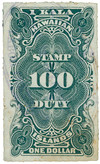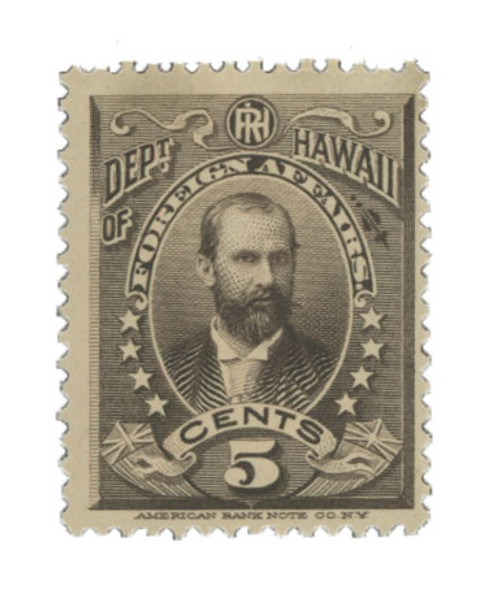
# HR3 - 1877 $1 Hawaii Revenue Stamp, black, engraved, unwatermarked, rouletted 8
Hawaii Revenue Stamp...
Funded Lifestyle of The Merrie Monarch
Known for his extravagance and belief in the absolute power of the monarchy, Hawaii’s King Kalakaua imposed taxes on an array of instruments – including bills of lading, bills of sale and mortgages. The most common tax was $1, payable with #HR3 of the first adhesive Hawaiian revenue stamp series. The taxes helped fund King Kalakaua’s world tour and Hawaii’s grand Iolani Palace.
Although he earned the nickname “The Merrie Monarch” for his spendthrift nature, Kalakaua also established Hawaii’s largest public park, maternity hospital and telephone system.
Hawaii Revenues –
A Great Collecting Adventure
This beautifully engraved stamp was printed by the American Bank Note Company. The purpose of revenue stamps is to apply a tax (duty) on a specific item purchased. A person buying anything from playing cards to opium would pay a fee to the government. The denomination on the stamp would determine the amount paid to the government.
The main purpose of these particular stamps was to tax the sale of opium. With the introduction of Chinese labor came the habit of smoking opium. The question of legalizing opium had been a controversial policy in the Hawaiian government since the introduction of the drug to the islands.
The licensing of the sale of opium was permitted at the whim of legislators and the ruling sovereign. It was first introduced under King David Kalakaua’s reign. He was later accused of receiving a bribe relating to the granting of the opium monopoly license. It was the general consensus that he was guilty of this. He is said to have received $71,000 as a “present” for granting a specific party the opium monopoly license. He did not grant the license to this party, and it was suggested he received a better “present” from someone else. There is a great deal of sworn testimony to this affect from the individual who gave the king the $71,000, but there were no repercussions from the testimony, and the money was not returned. The legislature later repealed Kalakaua’s opium bill.
Under Queen Liliuokalani’s regime, opium was legalized for a short time. The reason it was passed through the legislators was that they believed licensing was the only way to solve the trafficking problem. They believed the practice of bringing drugs into the country illegally would not stop. It seemed to them the best remedy for the situation was to license the drug, so it could be better controlled by the government.
The sale of liquor, another frequently taxed item, had a fair amount of historical significance on Hawaiian society. It was legalized on the whim of the monarch, or other legislative bodies in power at the time. The issue of legality changed with different administrations. Prohibition was sometimes practiced. At first, a ban on importation of strong liquors such as whiskey and brandy was imposed. Then it was simply “controlled” as those in power saw fit. The only alcoholic beverage known to Hawaiians before the whites came to the islands was awa, made from the root of a pepper plant. With the haoles, or white men, came the importation of strong liquor. The natives of the island were used to a much milder narcotic in their awa and the affect of liquor on their sheltered society was detrimental. Several of the monarchs themselves were given to drinking binges. As their society matured, and Hawaiians became more educated, the people could deal with this new drug more effectively.
Hawaii Revenue Stamp...
Funded Lifestyle of The Merrie Monarch
Known for his extravagance and belief in the absolute power of the monarchy, Hawaii’s King Kalakaua imposed taxes on an array of instruments – including bills of lading, bills of sale and mortgages. The most common tax was $1, payable with #HR3 of the first adhesive Hawaiian revenue stamp series. The taxes helped fund King Kalakaua’s world tour and Hawaii’s grand Iolani Palace.
Although he earned the nickname “The Merrie Monarch” for his spendthrift nature, Kalakaua also established Hawaii’s largest public park, maternity hospital and telephone system.
Hawaii Revenues –
A Great Collecting Adventure
This beautifully engraved stamp was printed by the American Bank Note Company. The purpose of revenue stamps is to apply a tax (duty) on a specific item purchased. A person buying anything from playing cards to opium would pay a fee to the government. The denomination on the stamp would determine the amount paid to the government.
The main purpose of these particular stamps was to tax the sale of opium. With the introduction of Chinese labor came the habit of smoking opium. The question of legalizing opium had been a controversial policy in the Hawaiian government since the introduction of the drug to the islands.
The licensing of the sale of opium was permitted at the whim of legislators and the ruling sovereign. It was first introduced under King David Kalakaua’s reign. He was later accused of receiving a bribe relating to the granting of the opium monopoly license. It was the general consensus that he was guilty of this. He is said to have received $71,000 as a “present” for granting a specific party the opium monopoly license. He did not grant the license to this party, and it was suggested he received a better “present” from someone else. There is a great deal of sworn testimony to this affect from the individual who gave the king the $71,000, but there were no repercussions from the testimony, and the money was not returned. The legislature later repealed Kalakaua’s opium bill.
Under Queen Liliuokalani’s regime, opium was legalized for a short time. The reason it was passed through the legislators was that they believed licensing was the only way to solve the trafficking problem. They believed the practice of bringing drugs into the country illegally would not stop. It seemed to them the best remedy for the situation was to license the drug, so it could be better controlled by the government.
The sale of liquor, another frequently taxed item, had a fair amount of historical significance on Hawaiian society. It was legalized on the whim of the monarch, or other legislative bodies in power at the time. The issue of legality changed with different administrations. Prohibition was sometimes practiced. At first, a ban on importation of strong liquors such as whiskey and brandy was imposed. Then it was simply “controlled” as those in power saw fit. The only alcoholic beverage known to Hawaiians before the whites came to the islands was awa, made from the root of a pepper plant. With the haoles, or white men, came the importation of strong liquor. The natives of the island were used to a much milder narcotic in their awa and the affect of liquor on their sheltered society was detrimental. Several of the monarchs themselves were given to drinking binges. As their society matured, and Hawaiians became more educated, the people could deal with this new drug more effectively.















